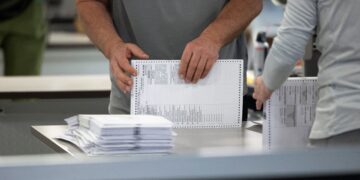* Prime Minister Anthony Albanese pledged A$74 billion for
missile
acquisition last year
* Country builds partnerships with Lockheed Martin,
Kongsberg and
Raytheon
* Lockheed Martin says in talks over hypersonic weapons
AVALON, Australia, March 27 (Reuters) – The Ukraine war
and increased European defence spending are likely to slow
Australia’s plans to develop its own missile components’
capability as it pushes ahead with a multibillion-dollar effort
to acquire long-range strike missiles.
Prime Minister Anthony Albanese pledged A$74 billion ($47
billion) last year for missile acquisition including A$21
billion to establish a Guided Weapons and Explosive Ordnance
Enterprise in Australia, as his Labor government reshaped the
country’s defence strategy to respond to China’s military
build-up.
Hedging against global supply issues, Australia signed a
flurry of orders with U.S. and European defence companies,
including Lockheed Martin, Kongsberg and Raytheon.
Lockheed Martin President for Missiles and Fire Control Tim
Cahill said that the U.S. company was in discussions with
Australia on “long term and short term solutions” for hypersonic
missiles, which Australia wants to defend its northern borders.
“Long range strike and hypersonics – long range fast strike
and very survivable strike – is clearly a priority,” Cahill said
in an interview at this week’s Avalon Air Show.
Gathered at the event in the southern state of Victoria,
defence executives said global missile component shortages and
high demand, and the need to improve the capacity of Australian
suppliers, meant Australian components would only gradually be
built into local production.
Norway’s Kongsberg plans to have a common supply chain
between Europe, the United States and the Indo Pacific when new
factories in Australia and the United States open, with the
workload distributed across the facilities, said its Executive
Vice President of Missiles & Space Oyvind Kolset.
“Of course the demand is extremely high now, it’s a
challenge to ramp up at the rate we are doing now, but at least
we have worked on this for a number of years,” Kolset said,
referring to missile production for the Ukraine war.
Australia’s Defence Department said the first guided missile
production in Australia by Kongsberg, of its Joint Strike
Missile and Naval Strike Missile, would start in 2027.
The company has also contracted 10 Australian suppliers for
possible work on installations of its Naval Strike Missile on
the deck of Australian frigates, said Kongsberg Australia
general manager John Fry.
Some parts of the missile supply chain require more
industrial capacity than Australian currently has, he said.
“Making the missile from scratch with today’s capability
wouldn’t be possible. We can’t do that in Norway either, we rely
on suppliers in the U.S. and Europe,” said Kolset.
Lockheed Martin, meanwhile, expects to produce Guided
Multiple Launch Rocket Systems (GMLRS) in Australia this year.
The supply of solid rocket motors needed for GMLRS in the
United States was “not sufficient”, Cahill said in an example of
global shortages.
Cahill said Australia’s Guided Weapons and Explosive
Ordnance Enterprise was strategically important and would bring
high capacity production outside the United States for the first
time.
Although 60 local companies had been identified as potential
suppliers, Australian content would be slowly be brought in, he
said.
Lockheed Martin has delivered the first two of 42 High
Mobility Artillery Rocket Systems (HIMARS) launcher vehicles
ordered by Australia, even with the demand in Ukraine.
Australia has said army regiments with HIMARS can be
transported by C-17 aircraft to neighbouring island states,
which have defence agreements with Australia, in any regional
conflict.
Australia will select a second order of land-based missile
systems by the end of the year, with HIMARS and Kongsberg’s
Naval Strike Missile mounted on an Australian-made Bushmaster
truck shortlisted.
Kongsberg’s Kolset said the United States Marines Corp was
already deploying its system in the region. “For the Marines,
this is their highest priority programme,” he said.
($1 = 1.5853 Australian dollars)
(Reporting by Kirsty Needham in Avalon; Editing by Kate
Mayberry and Lincoln Feast.)
















